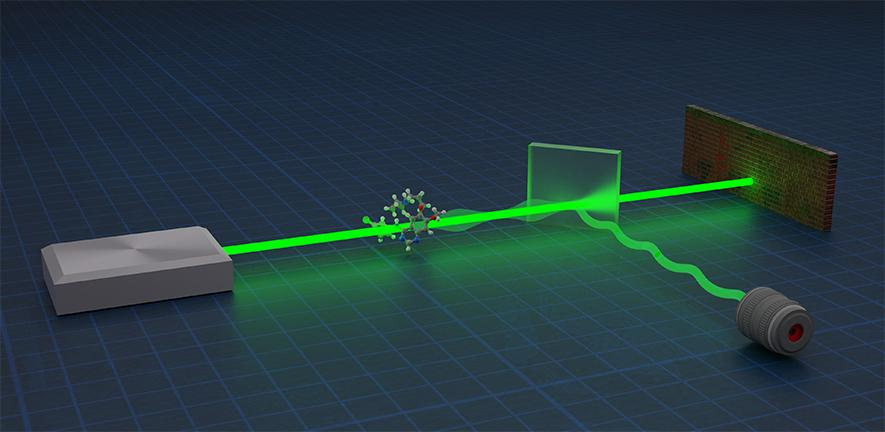Jul 30 2020
Researchers have discovered that “quantum negativity”—a type of physical property—can be employed to take more accurate measurements of everything, right from gravitational waves to molecular distances.
 Quantum laser light is shone onto a chemical molecule that we wish to measure. Then the light passes our “magic” quantum filter. This filter discards a lot of light, whilst condensing all useful information in weak light that finally reaches the camera detector. Image Credit: Hugo Lepage.
Quantum laser light is shone onto a chemical molecule that we wish to measure. Then the light passes our “magic” quantum filter. This filter discards a lot of light, whilst condensing all useful information in weak light that finally reaches the camera detector. Image Credit: Hugo Lepage.
The research team, from the University of Cambridge, Harvard University, and MIT, has demonstrated that quantum particles are capable of carrying an infinite amount of data about things they have communicated with.
The latest study may lead to far more accurate measurements and drive novel technologies, like quantum computers and super-precise microscopes. The study results were reported in the Nature Communications journal.
Metrology denotes the science of measurements and science of estimations. If individuals have weighed themselves this morning, it means they have done metrology. Just like how quantum computing is anticipated to redefine the way complex calculations are performed, quantum metrology—which uses the peculiar behavior of subatomic particles—may transform the way things are quantified.
Individuals are used to handling probabilities that span between 0% (never happens) and 100% (always happens). But to elucidate results from the quantum realm, the probability concept should be extended to include a supposed quasi-probability, which, incidentally, can be negative.
A quasi-probability like this helps explain quantum concepts, like Albert Einstein’s “spooky action at a distance” as well as wave-particle duality in a mathematical, intuitive language. For instance, the likelihood of an atom being at a specific position and moving at a particular pace may be a negative number, like –5%.
If negative probabilities are required to explain a certain experiment, the latter is believed to have “quantum negativity.” Now, the researchers have demonstrated that such quantum negativity can be used to make more accurate measurements.
Probes are required for all metrologies. They can be either thermometers or simple scales. But in advanced metrology, the probes are actually quantum particles, which can be managed at the sub-atomic level. Quantum particles like these are made to communicate with the thing being quantified. These quantum particles are subsequently examined by a detection device.
Theoretically, if there are a greater number of probing particles, then more data will be available for the detection device. However, in reality, there is a cap on the speed at which the detection devices can probe particles.
The same concept holds true in daily life: wearing sunglasses can filter out surplus light and enhance vision. However, there is a limit to how much filtering can enhance one’s vision—wearing extremely dark sunglasses is actually detrimental.
We’ve adapted tools from standard information theory to quasi-probabilities and shown that filtering quantum particles can condense the information of a million particles into one. That means that detection devices can operate at their ideal influx rate while receiving information corresponding to much higher rates. This is forbidden according to normal probability theory, but quantum negativity makes it possible.
Dr David Arvidsson-Shukur, Study Lead Author, Cavendish Laboratory, University of Cambridge
Dr Arvidsson is also the Sarah Woodhead Fellow at Girton College.
At the University of Toronto, an experimental team has already begun to build a technology to apply these novel theoretical outcomes. The team’s aim is to develop a quantum device that employs single-photon laser light to offer remarkably accurate measurements of optical parts. Measurements like these are significant for producing sophisticated new technologies, like photonic quantum computers.
“Our discovery opens up exciting new ways to use fundamental quantum phenomena in real-world applications,” added Arvidsson-Shukur.
Quantum metrology is capable of enhancing measurements of things, such as angles, distances, magnetic fields, and temperatures. Such highly accurate measurements can result in faster and more improved technologies, and also lead to better resources to analyze fundamental physics and enhance one’s interpretation of the universe.
For instance, there are several technologies that depend on the accurate alignment of parts or the potential to perceive slight variations in magnetic or electric fields. Greater accuracy in aligning mirrors can lead to more accurate telescopes or microscopes, and better means of quantifying the magnetic field of earth can result in more improved navigation tools.
At present, quantum metrology is used for improving the accuracy of gravitational wave detection in the LIGO Hanford Observatory that won the Nobel Prize. However, quantum metrology has been too costly for a number of applications, and could not be achieved with present-day technology. However, the recently published results provide a cheaper alternative to performing quantum metrology.
Scientists often say that ‘there is no such thing as a free lunch’, meaning that you cannot gain anything if you are unwilling to pay the computational price. However, in quantum metrology this price can be made arbitrarily low. That’s highly counterintuitive, and truly amazing!
Aleksander Lasek, Study Co-Author and PhD Candidate, Cavendish Laboratory, University of Cambridge
According to Dr Nicole Yunger Halpern, the study’s co-author and ITAMP Postdoctoral Fellow at Harvard University, “Everyday multiplication commutes: Six times seven equals seven times six. Quantum theory involves multiplication that doesn’t commute. The lack of commutation lets us improve metrology using quantum physics.”
Quantum physics enhances metrology, computation, cryptography, and more; but proving rigorously that it does is difficult. We showed that quantum physics enables us to extract more information from experiments than we could with only classical physics. The key to the proof is a quantum version of probabilities—mathematical objects that resemble probabilities but can assume negative and non-real values.
Dr Nicole Yunger Halpern, Study Co-Author and ITAMP Postdoctoral Fellow, Harvard University
Journal Reference:
Arvidsson-Shukur, D. R. M., et al. (2020) Quantum advantage in postselected metrology. Nature Communications. doi.org/10.1038/s41467-020-17559-w.